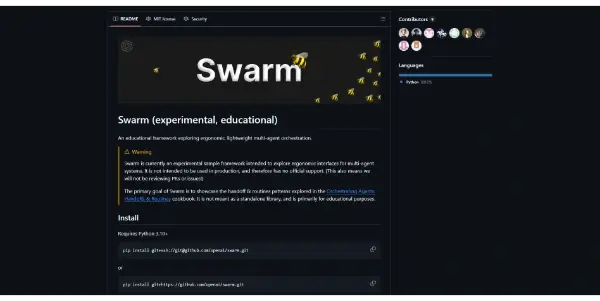Swarm by OpenAI

An open-source educational framework from OpenAI for exploring AI agent orchestration. Create lightweight, customizable multi-agent systems for complex tasks
Swarm: OpenAI's Open-Source Framework for AI Agent Orchestration
OpenAI's Swarm is a groundbreaking, open-source educational framework designed to simplify the exploration and development of multi-agent AI systems. It allows developers to create lightweight, customizable systems composed of multiple interacting agents, tackling complex tasks beyond the capabilities of single agents. This article delves into Swarm's functionalities, benefits, applications, and its position within the broader landscape of AI agent orchestration tools.
What Swarm Does
Swarm provides a streamlined environment for building and experimenting with multi-agent systems. Instead of wrestling with complex distributed systems infrastructure, Swarm offers a readily accessible platform where users can focus on the core logic of agent interaction and task allocation. It abstracts away much of the underlying complexity, making it ideal for educational purposes and rapid prototyping. Essentially, Swarm empowers users to define agents with specific behaviors, specify their interactions, and observe the emergent behavior of the system as a whole.
Main Features and Benefits
Lightweight and Easy to Use: Swarm's design emphasizes simplicity. Its lightweight architecture minimizes setup overhead, enabling quick experimentation and iteration. The framework's intuitive interface facilitates rapid prototyping and reduces the barrier to entry for developers new to multi-agent systems.
Customizable Agents: Users enjoy complete control over agent design. Agents can be customized with different algorithms, communication protocols, and decision-making strategies. This flexibility allows for exploration of diverse agent architectures and their impact on overall system performance.
Modular Design: Swarm's modular architecture promotes code reusability and extensibility. Users can easily incorporate new agents, algorithms, and communication methods into existing systems. This encourages experimentation and the development of increasingly sophisticated multi-agent systems.
Open-Source and Collaborative: As an open-source project hosted on GitHub, Swarm fosters a collaborative environment. Developers can contribute to its development, share their creations, and learn from the wider community. This collaborative approach accelerates innovation and expands the framework's capabilities.
Focus on Education: Swarm is primarily designed as an educational tool. Its simplified structure and clear documentation make it an excellent resource for students and researchers seeking to understand the principles of multi-agent systems.
Use Cases and Applications
Swarm's versatility opens doors to a wide array of applications:
Robotics Simulation: Simulate and coordinate the actions of multiple robots in a shared environment, such as warehouse automation or search and rescue operations.
Game AI: Develop sophisticated game AI systems where multiple agents (e.g., characters in a strategy game) interact and compete.
Distributed Problem Solving: Tackle complex problems requiring the combined efforts of multiple agents, such as resource allocation or distributed sensor networks.
Educational Purposes: Serve as a hands-on learning tool for understanding concepts related to AI agents, distributed systems, and emergent behavior.
Prototyping and Experimentation: Rapidly prototype new multi-agent system designs and test various algorithms and strategies before deploying them in more complex environments.
Comparison to Similar Tools
While several tools facilitate multi-agent system development, Swarm distinguishes itself through its simplicity and focus on education. Tools like Ray and Massively Parallel Processing (MPP) databases offer powerful capabilities for distributed computing, but often involve a steeper learning curve. Swarm prioritizes ease of use, making it accessible to a broader range of users. Other frameworks might focus on specific applications (e.g., robotics simulations), whereas Swarm's general-purpose nature makes it more versatile.
Pricing Information
Swarm is completely free to use. Its open-source nature ensures accessibility for anyone interested in exploring multi-agent AI systems.
Conclusion
OpenAI's Swarm offers a valuable resource for anyone seeking to explore the exciting field of multi-agent AI. Its user-friendly design, coupled with its open-source nature and wide range of potential applications, makes it a powerful tool for both educational purposes and practical development. Its emphasis on simplicity and customization empowers both novice and experienced developers to build and experiment with sophisticated multi-agent systems, fostering innovation and accelerating the advancement of AI.